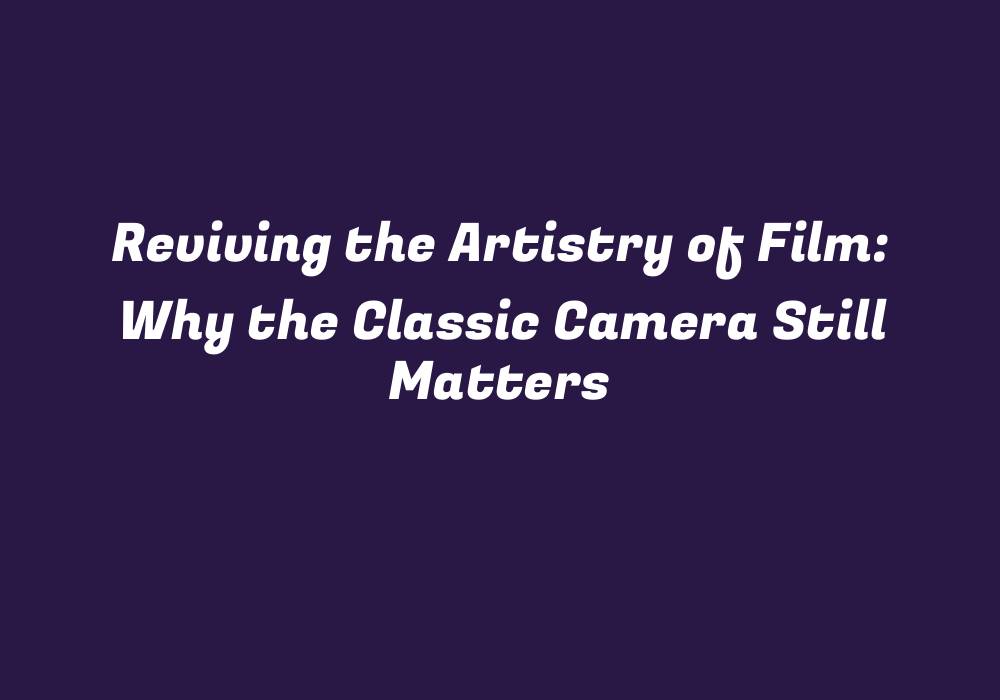Reviving the Artistry of Film: Why the Classic Camera Still Matters
In a world dominated by digital photography and smartphones, there’s an increasing yearning for reconnecting with the roots of cinematography. This desire to rediscover film’s rich history and appreciate its unique aesthetic qualities has led to the revival of using classic cameras in modern photography projects.
Reviving a Timeless Artistry
Film photography is more than just capturing moments on analogue formats; it’s an art form that inspires creativity and invites experimentation. The process involves a combination of craftsmanship, technique, and visual storytelling. By using classic cameras, photographers can hone their skills in a different realm of image-making while preserving the essence of cinema. With the surge of digital photography, many have lost touch with film’s inherent qualities like graininess, depth of field, and vibrant colors, which all contribute to the medium’s uniqueness.
The Allure of Film: Grainy Textures and Aesthetic Depth
One of the most recognizable traits of analogue photography is its grainy texture. This natural noise adds a layer of depth to an image that digital photography has been unable to replicate. While many photographers enjoy the clean, sharp quality of modern cameras, others find charm in embracing the imperfections and nostalgia that come with film’s distinctive look.
The use of classic cameras encourages a different approach to composing and capturing photographs. In order to make the most of the limited number of frames on film rolls, photographers must carefully consider every angle, light source, and composition, resulting in more thoughtful imagery that showcases their artistic vision.
Preserving Film’s Legacy: The Evolution of Technology
Film photography has undergone a remarkable evolution throughout its history. From the invention of the first photographic camera in 1816 by Joseph Nicéphore Niépce to the advancements made with digital technology, film cameras have adapted to meet the changing needs of photographers and remain relevant even today.
With the introduction of medium format cameras like the Hasselblad, Polaroid SX-70, and Mamiya RB67, film photography reached new heights in the 1950s and 1960s. These iconic cameras not only revolutionized photographers’ work but also played a significant role in shaping our visual culture.
The Role of Film in Cinematic Storytelling
Film photography has had an undeniable impact on cinema. With the introduction of cameras like the Arriflex 35, the Mitchell BNC, and the Panavision Panaflex, filmmakers began to capture stories with unparalleled clarity and depth. These cameras’ ability to create stunning visuals while maintaining a sense of authenticity has left an indelible mark on the world of cinema.
Reviving Film Photography: A Niche for Experimentation
As digital photography dominates the industry, many professionals seek refuge in analogue photography to explore new creative possibilities. The use of classic cameras provides an opportunity to step away from modern photography trends and experiment with unique techniques and approaches that cannot be achieved through digital imaging alone.
Photographers can explore various film stocks and processing methods, discovering the nuances of each combination and creating a diverse range of images. By embracing these experimental aspects, artists can uncover new ways to express their ideas, further enriching the artistry of film photography.
Preserving Film’s Legacy: The Future of Analogue Photography
While the future of film photography remains uncertain, its resurgence has sparked a renewed interest in its unique aesthetic qualities and timeless artistry. As more artists choose to incorporate classic cameras into their work, film photography continues to evolve as an ever-evolving medium that offers a distinct perspective on visual storytelling.
By embracing the nostalgia of vintage equipment and the challenges of working within the constraints of analogue formats, photographers can rediscover the beauty of film and its ability to captivate audiences in an entirely new way. In doing so, they contribute to the preservation of this once-ubiquitous art form that has left a lasting mark on cinematography.
Conclusion
Reviving the artistry of film photography through the use of classic cameras allows us to appreciate its rich history and unique aesthetic qualities. As digital technology continues to advance, it’s essential to recognize the continued relevance of analogue imaging within modern visual storytelling. By embracing the challenges and opportunities inherent in these traditional formats, we can nurture the artistic potential of film photography while preserving its legacy for generations to come.
As digital cameras become increasingly ubiquitous, let’s not forget the timeless artistry that lies within the world of film photography. By utilizing classic cameras and exploring their unique capabilities, we can breathe new life into this remarkable medium and ensure its lasting impact on the world of visual storytelling.
